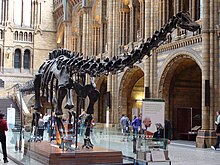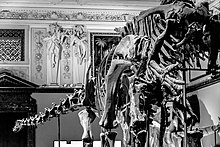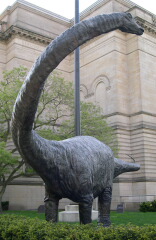
Apatosaurus is a genus of herbivorous sauropod dinosaur that lived in North America during the Late Jurassic period. Othniel Charles Marsh described and named the first-known species, A. ajax, in 1877, and a second species, A. louisae, was discovered and named by William H. Holland in 1916. Apatosaurus lived about 152 to 151 million years ago (mya), during the late Kimmeridgian to early Tithonian age, and are now known from fossils in the Morrison Formation of modern-day Colorado, Oklahoma, New Mexico, Wyoming, and Utah in the United States. Apatosaurus had an average length of 21–23 m (69–75 ft), and an average mass of 16.4–22.4 t. A few specimens indicate a maximum length of 11–30% greater than average and a mass of approximately 33 t.

Stegosaurus is a genus of herbivorous, four-legged, armored dinosaur from the Late Jurassic, characterized by the distinctive kite-shaped upright plates along their backs and spikes on their tails. Fossils of the genus have been found in the western United States and in Portugal, where they are found in Kimmeridgian- to Tithonian-aged strata, dating to between 155 and 145 million years ago. Of the species that have been classified in the upper Morrison Formation of the western US, only three are universally recognized: S. stenops, S. ungulatus and S. sulcatus. The remains of over 80 individual animals of this genus have been found. Stegosaurus would have lived alongside dinosaurs such as Apatosaurus, Diplodocus, Camarasaurus and Allosaurus, the latter of which may have preyed on it.

John Bell Hatcher was an American paleontologist and fossil hunter known as the "king of collectors" and best known for discovering Torosaurus and Triceratops, two genera of dinosaurs described by Othniel Charles Marsh. He was part of a new, professional middle class in American science, having financed his education with his labor while also being more educated than older fossil collectors. As such, he faced unique challenges throughout his long and productive career.

The Natural History Museum in London is a museum that exhibits a vast range of specimens from various segments of natural history. It is one of three major museums on Exhibition Road in South Kensington, the others being the Science Museum and the Victoria and Albert Museum. The Natural History Museum's main frontage, however, is on Cromwell Road.

The Museum of Natural Sciences of Belgium is a museum dedicated to natural history, located in Brussels, Belgium. The museum is a part of the Royal Belgian Institute of Natural Sciences. Its most important pieces are 30 fossilised Iguanodon skeletons, which were discovered in 1878 in Bernissart, Belgium.

The Natural History Museum is a natural history museum located in Berlin, Germany. It exhibits a vast range of specimens from various segments of natural history and in such domain it is one of three major museums in Germany alongside Naturmuseum Senckenberg in Frankfurt and Museum Koenig in Bonn.

Barosaurus was a giant, long-tailed, long-necked, plant-eating sauropod dinosaur closely related to the more familiar Diplodocus. Remains have been found in the Morrison Formation from the Upper Jurassic Period of Utah and South Dakota. It is present in stratigraphic zones 2–5.

The Carnegie Museum of Natural History is a natural history museum in the Oakland neighborhood of Pittsburgh, Pennsylvania. It was founded by Pittsburgh-based industrialist Andrew Carnegie in 1896. Housing some 22 million specimens, the museum features one of the finest paleontological collections in the world.

Brontosaurus is a genus of herbivorous sauropod dinosaur that lived in present-day United States during the Late Jurassic period. It was described by American paleontologist Othniel Charles Marsh in 1879, the type species being dubbed B. excelsus, based on a partial skeleton lacking a skull found in Como Bluff, Wyoming. In subsequent years, two more species of Brontosaurus were named: B. parvus in 1902 and B. yahnahpin in 1994. Brontosaurus lived about 156 to 146 million years ago (mya) during the Kimmeridgian and Tithonian ages in the Morrison Formation of what is now Utah and Wyoming. For decades, the animal was thought to have been a taxonomic synonym of its close relative Apatosaurus, but a 2015 study by Emmanuel Tschopp and colleagues found it to be distinct. It has seen widespread representation in popular culture, being the archetypal "long-necked" dinosaur in general media.

Sue is the nickname given to FMNH PR 2081, which is one of the largest, most extensive, and best preserved Tyrannosaurus rex specimens ever found, at over 90 percent recovered by bulk. FMNH PR 2081 was discovered on August 12, 1990, by American explorer and fossil collector Sue Hendrickson, and was named after her.
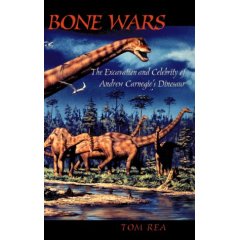
Bone Wars: The Excavation and Celebrity of Andrew Carnegie's Dinosaur is a nonfiction book by Tom Rea detailing a partial history of the Bone Wars, specifically the late-Victorian scientific drama surrounding the diplodocus skeleton "Dippy".

Tyrannosaurus rex is one of the most iconic dinosaurs and is known from numerous specimens, some of which have individually acquired notability due to their scientific significance and media coverage.

The Museum of Evolution of Polish Academy of Sciences is the display area of the natural history museum in Warsaw, Poland. It is the public front of the Muzeum i Instytut Zoologii or Zoology Museum and the Instytut Paleobiologii or Paleobiology Institute. It is based at the Palace of Culture and Science.
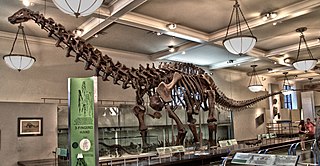
Apatosaurinae is a subfamily of diplodocid sauropods, an extinct group of large, quadrupedal dinosaurs, the other subfamily in Diplodocidae being Diplodocinae. Apatosaurines are distinguished by their more robust, stocky builds and shorter necks proportionally to the rest of their bodies. Several fairly complete specimens are known, giving a comprehensive view of apatosaurine anatomy.

Diplodocus was a genus of diplodocid sauropod dinosaurs, whose fossils were first discovered in 1877 by S. W. Williston. The generic name, coined by Othniel Charles Marsh in 1878, is a Neo-Latin term derived from Greek διπλός (diplos) "double" and δοκός (dokos) "beam", in reference to the double-beamed chevron bones located in the underside of the tail, which were then considered unique.
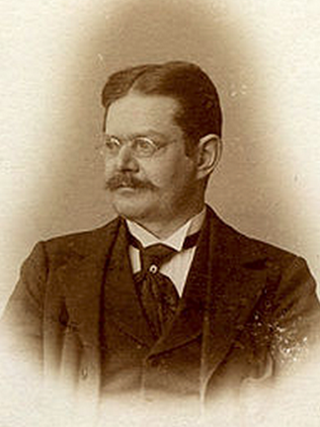
Gustav Tornier was a German zoologist and herpetologist.

The London cast of Dippy is a plaster cast replica of the fossilised bones of a Diplodocus carnegii skeleton, the original of which – also known as Dippy – is on display at Pittsburgh's Carnegie Museum of Natural History. The 26-metre (85 ft) long cast was displayed between 1905 and 2017 in the Natural History Museum in London, becoming an iconic representation of the museum. It began a national tour of British museums in February 2018. Dippy returned to London in June 2022, and then moved to Coventry as a long-term loan to the Herbert Art Gallery & Museum in 2023.

Hope is the skeleton of a blue whale displayed in the main hall of the Natural History Museum, London.
Attenborough and the Giant Dinosaur is a 2016 British nature documentary programme made for BBC Television, first shown in the UK on BBC One on 24 January 2016, and in the US on 17 February 2016 on PBS. The programme is presented and narrated by Sir David Attenborough. It presents the state of knowledge at the time of the excavation of the fossilised remains of seven individuals of a new species of titanosaur, unnamed at the time of the programme.



